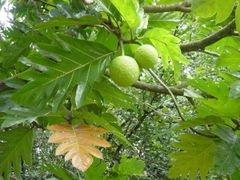A special case is Ca9-8, where there are 6 'berries' instead of 4:
 |
| Ca9-8 |
| ku tupu te poporo |
6 could refer to the Sun and 9 * 8 = 72 = 360 / 5 also suggests the Sun.
Poporo is the name of a plant and it is number 8 in a list of plants which belonged to Oti:
| First page numbered 69 in Manuscript E: |
| he hauhau. |
he mahute. |
- |
| p. 68: |
| he ngaatu |
he tavari |
he riku |
he ngaoho |
he naunau. |
a Oti. |
| he uku koko |
he nehenehe |
he poporo. |
8 items so far |
| he kavakava atua |
he kohe. |
10 so far |
| he nehenehe |
he pua |
he harahara |
he hua taru. |
14 so far |
| he makere |
he hata. |
insects |
| he tuere heu. |
16 so far |
| he tureme |
| Second page numbered 69: |
| he matie. |
19 items belonging to Oti. |
a Oti. |
| he pua nakonako. |
| he ipu ngutu |
The full stops in Manuscript E obviously could have the same function as the dots in the rongorongo texts - viz. to make the reader count, as for instance at Cb8-6:
The purpose of including insect species among the species of plants should be clear if we consider what will happen if bumble-bees and other more or less specialized insects would disappear - there would be no pollination and the plants would disappear because they could not generate offspring. The true reason for the high regard of insects in Southeast Asia should therefore reevaluated:
... From a religious point of view, the high regard for flies, whose increase or reduction causes a similar increase or reduction in the size of the human population, is interesting, even more so because swarms of flies are often a real nuisance on Easter Island, something most visitors have commented on in vivid language.
The explanation seems to be that there is a parallel relationship between flies and human souls, in this case, the souls of the unborn. There is a widespread belief throughout Polynesia that insects are the embodiment of numinous beings, such as gods or the spirits of the dead, and this concept extends into Southeast Asia, where insects are seen as the embodiment of the soul ...
Colonizing an unihabited island in the vast sea without not only the necessary food plants but also the coresponding insects would be disastrous. As to what plant he poporo referred to we should first to consider the plant the Hawaiians called popolo:
| "Solanum nigrum (Black Nightshade, Duscle, Garden Nightshade, Hound's Berry, Petty Morel, Small-fruited black nightshade, Sunberry, or Wonderberry) is a species in the Solanum genus, native to Eurasia and also introduced in the Americas. In Hawaii it is called popolo. The green berries and mature leaves contain glycoalkaloids and are poisonous to eat raw. Their toxicity varies and there are some strains which have edible berries when fully ripe. The plant has a long history of medicinal usage, dating back to ancient Greece. In India, the berries are casually grown and eaten; but not cultivated for commercial use. In Tamil, the berries are called sundakai
Black nightshade is a fairly common plant, found in many wooded areas, as well as disturbed habitats. It has a height of 30-120 cm (12-48"), leaves 4-7.5 cm (1 1/2-3") long; ovate to heart-shaped, with wavy or large-toothed edges. The flowers have petals greenish to whitish, recurved when aged and surround prominent bright yellow anthers. The fruits are oval black berries in small hanging clusters.

(Wikipedia) |
Barthel has furthermore suggested why the glyph type hua poporo normally carries 4 'berries': ... He points out that in the Marquesas they counted the fruits from the breadfruit trees in fours, perhaps thereby explaining the four 'berries' in this type of glyph. The breadfruit did not grow on Easter Island but the berries of Solanum nigrum were eaten in times of famine.
Barthel compares with the word koporo on Mangareva. The poor crop of breadfruits at the end of the harvest season was called mei-koporo, where mei stood for breadfruit. On other islands breadfruit was called kuru, except in the Marquesas which also used the word mei. Koporo was a species of nightshade.
| "Breadfruit (Artocarpus altilis) is a tree and fruit native to the Malay Peninsula and western Pacific islands. It has also been widely planted in tropical regions elsewhere. It was collected and distributed by Lieutenant William Bligh as one of the botanical samples collected by HMS Bounty in the late 18th century, on a quest for cheap, high-energy food sources for British slaves in the West Indies ... According to an etiological Hawaiian myth, the breadfruit originated from the sacrifice of the war god Kū. After deciding to live secretly among mortals as a farmer, Ku married and had children. He and his family lived happily until a famine seized their island. When he could no longer bear to watch his children suffer, Ku told his wife that he could deliver them from starvation, but to do so he would have to leave them. Reluctantly, she agreed, and at her word, Ku descended into the ground right where he had stood until only the top of his head was visible. His family waited around the spot he had last been day and night, watering it with their tears until suddenly a small green shoot appeared where Ku had stood. Quickly, the shoot grew into a tall and leafy tree that was laden with heavy breadfruits that Ku's family and neighbors gratefully ate, joyfully saved from starvation ...

(Wikipedia) |
|



